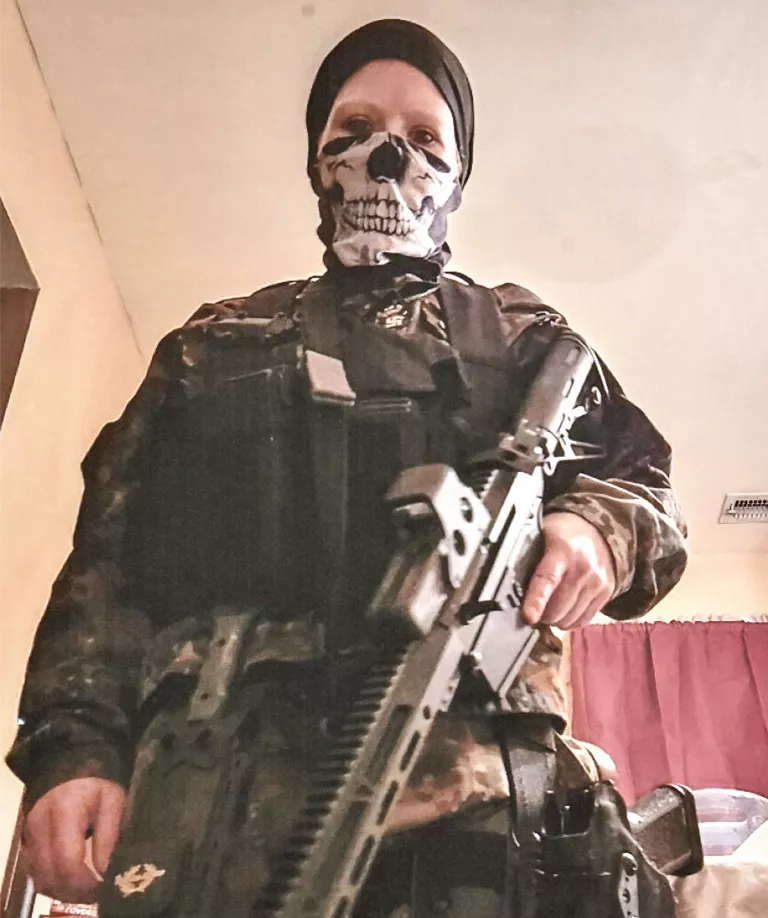Latest Threat to the Electricity Grid: White Supremacists
Neo-Nazi "accelerationists" hoping to hasten the collapse of society are targeting electrical substations

Photo by Amy Davis/Baltimore Sun
Pale and petite, and with a penchant for swastikas, drop holsters, and large-caliber longarms, Sarah Beth Clendaniel told a colleague in mid-January that she had a terminal kidney disease and would probably live for only a few more months. Before the 34-year-old died, she wanted to "accomplish something worthwhile," the colleague recounted her saying. Her end-of-life ambition? The one act she believed would leave an indelible mark on the world? Shooting up electrical substations around Baltimore, Maryland. A couple of weeks later, she reiterated this aspiration: "If we can pull off what I'm hoping . . . this would be legendary."
For several years now, law enforcement and researchers have been monitoring racially and ethnically motivated violent white supremacist groups and their growing fascination with our country's power grid. Many in these groups are "accelerationists," convinced that the best way to achieve their goal of a white supremacist future is to cause society to collapse by plunging it into darkness. "The belief is, when the lights go out, people will become violent when they realize the government can't help them," said Joshua Fisher-Birch, a researcher with the Counter Extremism Project, an international policy organization. "It's also a great recruitment tactic." Attacking the electrical grid, he noted, is a topic of growing interest in the neo-Nazi tracts he's reviewed in recent months.
For all the power outages extremists have caused, society has yet to collapse.
White-power groups have been focused on grid sabotage since at least 2013, when a group of gunmen shot up 17 transformers at Pacific Gas & Electric's Metcalf electrical transmission substation in Coyote, California. The bullets did $15 million in damage, but the grid held. The perpetrators were never found, though, and far-right extremists have been inspired ever since by their clean getaway. When Fisher-Birch first began focusing on white supremacists in 2017, there was already chatter about the grid on the websites used by members of the Base and the Atomwaffen Division and other hard-core extremists. "It is something that is growing," he said. "We're seeing more talk as time goes on."
This far-right chatter coincides with a recent spike in attacks on electrical-grid infrastructure around the country. The Department of Energy's Electric Disturbance Events Summary cataloged 25 physical attacks in 2022, compared with six the year before. If you add in vandalism and "suspicious activity," there were 162 incidents—the highest level in at least a decade, according to an analysis by Politico. Recent attacks include the December 3, 2022, shooting of two electrical substations in Moore County, North Carolina, which plunged 45,000 people into darkness for days.
In the greater scheme of things, two dozen physical attacks, or even 100, are mere pinpricks in the country's overall system of 11,000 substations used to move power from electrical generating plants to homes. But experts are taking notice.
"It's a little early to say if this is going to be a massive trend," said Nicholas Eftimiades, the former chief of counterterrorism operations for the Defense Intelligence Agency and a professor of homeland security at Pennsylvania State University. "We may be looking at a new form of domestic terrorism that is far more difficult to detect and investigate." Protecting against this threat is equally difficult. "There are 56 FBI field offices and over 11,000 substations in this country," Eftimiades said. "Do the math."
Guarding each of these substations would be inordinately expensive (a cost that would no doubt be passed down to the consumer). That's part of what makes substations appealing targets to saboteurs. "Just these few cases are getting a lot of media and press, with minimal risk of loss of life and low risk of getting caught," Eftimiades said.
The good news is that the patchwork, nonstandardized nature of the US electrical grid makes large-scale outages unlikely. "Our systems are diverse, and that makes it difficult for a national attack," Eftimiades said. "Most damage is done regionally. We get this stuff knocked out all the time in hurricanes. And if we're not good at anything else, we're good at recovering."
The introduction of renewable energy sources, both at the grid level and the individual level, has also helped to "diversify the threat field," as Eftimiades put it. The renewable systems incorporated into the grid can be susceptible to cyberattacks (another new threat to the grid) but also provide reserves of power. And homeowners with solar panels and battery storage are generally immune to outside meddling.
So while extremists have found a low-risk target, attacking individual substations is unlikely to help them fulfill their dystopian fantasies. For all the power outages extremists have caused, society has yet to collapse. And the episodes are bringing a lot of negative attention to far-right extremism. "I could imagine a scenario where these neo-Nazi online accelerationist communities say to themselves, 'Wow, there's a lot of heat. Let's pivot away from this,'" researcher Fisher-Birch noted.
The Federal Energy Regulatory Commission is now studying how to strengthen the grid's security without incurring huge costs (for example, by widely deploying surveillance cameras). In an emailed statement, the Department of Energy said that it "works closely with industry and interagency partners, including federal law enforcement and the intelligence community, to help address all threats and hazards whenever they arise." A new Energy Threat Analysis Center will be created this year to coordinate government, law enforcement, and industry responses.
In the end, Clendaniel, who liked to pose for photos in a death's-head face mask, combat clothing with Nazi paraphernalia, and an assortment of weapons, was caught before she could do any harm. The colleague she confided in turned out to be an FBI source. In February, the FBI arrested Clendaniel and the man who allegedly recruited her, Brandon Clint Russell, the founder of the Atomwaffen Division. Prosecutors charged them in a Maryland federal court with conspiracy to damage an energy facility. They face up to 20 years in prison.
 The Magazine of The Sierra Club
The Magazine of The Sierra Club



